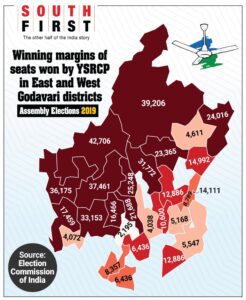It will be all about how the mercurial Kapus vote in the East and West Godavari districts, where they are concentrated.

TDP's N Chandrababu Naidu, YSRCP's Jagan Mohan Reddy and Jana Sena's Pawan Kalyan.
The alliance between the TDP and the Jana Sena Party (JSP) seems like a foregone conclusion. Speculation has been rife since more than a year now. Talks have happened in the recent past too.
The Opposition has put up a united face against the ruling YSRCP. In fact, leaders of both parties — a shrewd N Chandrababu Naidu and a maverick Pawan Kalyan — say that they are coming together to rid the state of Chief Minister YS Jagan Mohan Reddy’s “misrule”.
Whatever be the rhetoric surrounding the alliance, what will its electoral impact be in the upcoming Assembly Elections in 2024?
JSP chief Pawan Kalyan has repeatedly stressed the importance of forging a united Opposition to defeat the YSRCP. He said this recently in January when he vowed “to ensure the Opposition vote in Andhra Pradesh does not split in the 2024 elections”.
From the TDP’s point of view Pawan Kalyan will also help to consolidate votes from the numerically significant and restive Kapu community. The community’s voting is usually considered crucial in deciding the ultimate winner.
Kapu leader from the Guntur region, Kanna Lakshminarayana’s entry into the TDP recently is seen as a step in this very direction.
This is even more true considering the communities’ geographical spread and concentration of votes. Although the Kapus are present in Krishna and Guntur districts, they are highly concentrated in the delta districts of East and West Godavari.
Due to this concentration, their electoral impact is conspicuous in these two districts. In fact, this was borne out in the 2014 and 2019 Assembly election results.
There are 34 Assembly seats in East and West Godavari districts. Out of these, six are reserved for Scheduled Castes (SCs) and two are reserved for the Scheduled Tribes (STs).
In 2014, the TDP and BJP were in a pre-poll alliance. Although JSP did not contest, Pawan supported this alliance. The TDP managed to win 26 seats while its partner BJP won two seats. The YSRCP won five seats with an independent winning one seat.
In 2019, this situation reversed. The YSRCP managed to win 27 seats while the TDP won just six seats.
The JSP, which was in an alliance with the CPI(M) and the Bahujan Samaj Party (BSP), contested in 30 seats in these two districts and won just one seat. Pawan Kalyan himself lost from Bhimavaram constituency in West Godavari.
All things remaining same, this reversal in fortunes suggests that the crucial Kapu community backed the YSRCP.
There were violent agitations against the failure of the then TDP government to include them in the Backward Classes (BC) list.
In fact, given the disappointment over the lack of allotment of the ₹5,000 crore to the Kapu Corporation announced by the TDP, Jagan included a ₹2,000 crore per annum package to the corporation as a key promise in his election manifesto.
The fact that the Kapus did not even consolidate in favour of Pawan Kalyan’s JSP revealed that they were desperate for political power and placed all their bets on the winning horse, Jagan Mohan Reddy.
Given the above-mentioned context, we could make a few assumptions to try assess the likely electoral impact of the TDP-JSP alliance.
First, given the voting behaviour of the Kapu community over the last two elections, it can be assumed that they vote as a monolith (not 100 percent, but an overwhelming majority) for the winning party/combination.
Second, given the reversal of fortunes in 2014 and 2019, it can be safely assumed that there will be a reversal in this election too. In other words, the voting behaviour is sensitive and can change drastically.
Third, given the already well settled narrative of a united Opposition that is being articulated by Pawan Kalyan, we can assume a vote transfer between the alliance partners.
Fourth, given the recent clashes and the vehemence with which the community asserts itself, we can assume there is much disaffection against the YSRCP government, who the community see as favouring the Backward Classes and Dalits.
 Traditional seats for the alliance
Traditional seats for the alliance As mentioned earlier, the TDP only managed to win only six seats in 2019 elections. Interestingly, the yellow party won these seats in 2014 too. In other words, the party has managed to retain these six seats even when the tide was against them.
These are Peddapuram, Rajamundry City, Rajamundry Rural, Palacole, Undi and Gannavaram (SC). Therefore, it is safe to assume these seats will retained by the TDP-JSP (combination).
The JSP had won the reserved constituency Razole in 2019. This constituency was won by the TDP in 2014. Therefore, it can be assumed that this seat will be retained by the combination.
Out of the 27 seats that the YSRCP won in 2019 in these delta districts, it scraped home in four seats with a winning margin of less than 5,000 votes. In another five seats, the winning margin was between 5,000 and 10,000 votes.
These seats can be considered susceptible to flipping in favour of the TDP-JSP combination, especially if the combination can create enough buzz of their impending victory and if the swing voter perceives the combination to be winning to make his/her vote count.
Further analysis reveals that, in 15 seats, the JSP polled more votes than the winning margin of the YSRCP. This means that in case of an alliance, if these votes polled by the JSP are transferred to the TDP’s share of votes, they can manage to upset the YSRCP.
Although such strict linear calculation need not work (1+1 need not necessarily be 2), these 15 seats will still be crucial to watch out for to elicit any meaningful election trends in these districts. This can be true especially for marginal or swing voters.
An analysis of the proximity of NOTA (None Of The Above) votes in constituencies where the YSRCP’s winning margin was low reveals that four seats — Eluru, Kothapeta, Ramachandrapuram and Tanuku — are susceptible to a flip. The certainty of this increases with the increase in the credibility of the combination as an alternative.
Meanwhile, the CPI(M) is open to an alliance with the TDP-JSP, provided the combination does not include the BJP.
If this transpires, further uniting the Opposition, then two more seats could flip. Although the CPI(M) did not win any seats in 2019, it had polled roughly 18,000 votes in Rampachodavaram (ST) and 25,000 votes in Undi constituencies.
This above analysis indicates that the YSRCP is likely to see reversals or a tough battle in at least 22-25 out the 27 seats it won in 2019. Moreover, it seems likely that the TDP and JSP together will retain at least seven seats.
But this is in no way a certain indicator of the overall performance of the YSRCP.
By winning a historic 151 seats in 2019, the party has maxed out in regions like Rayalaseema, Nellore and Chittoor. Even marginal anti-incumbency would mean the party can only lose seats.
The magic number is 88 to gain a simple majority. So, the YSRCP has a buffer of 63 seats.
Or, in other words, the party can afford to lose 63 seats and just scrape through.
So it will be interesting to see if these 22-25 seats in East and West Godavari will contribute towards this or not.

Apr 26, 2024

Apr 26, 2024

Apr 25, 2024

Apr 25, 2024

Apr 25, 2024

Apr 25, 2024